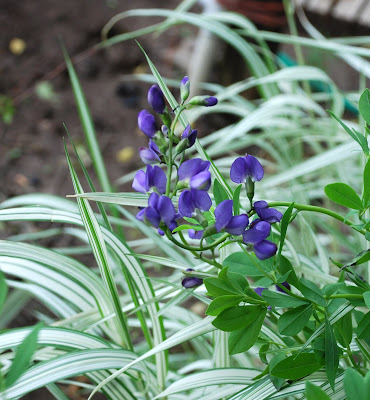Curly willow - beloved of flower arrangers. A floppy tree, it needs lots of water, but really is lovely in flower arrangements.
Rozanne, the best cranesbill geranium of all. It blooms and blooms and blooms this lovely neon blue color, and it winds around and fills up space around taller and more aggressive plants.
Blue baptisia against green and white grasses. These grasses can spread dramatically, but you can always cut out a chunk and put it in a pot with other plants.

Iris and old roses. It's hard to get a good shot of a group of perennial flowers, some of which may not be at their absolute best.

Seashell, the fragrant Japanese peony. The single peonies are stunning in vases.
Chinese tree peonies, among the loveliest of all plants. These are woody shrubs. Mine is five feet tall and eight feet wide, covered in early May with these crinkled crepe-paper beauties.

Double columbine. Hardly looks like a columbine at all.

Lily of the valley. You have to get close to smell the sweetness. These like deep shade, and once you get them growing and spreading, they crowd everything else out with their tough, ropy roots.

Saponaria, the wandering soapwort. This plant will simply not stay where I put it. It sulks and dies and tells me no, and then it wanders at will, spreading itself here and there in varying shades of pink, welcome wherever it shows up.

Viburnum Carlesii, the indispensable Korean Spice Viburnum, perfumes the whole yard with the powerful scent of carnations in April and May. Keep the windows open when this one is blooming.

Pulmonaria Raspberry Splash, among the very first bloomers in the spring. The rest of the summer and autumn season it decorates the ground with neat whorls of spotted green leaves.

Bridal Veil shrub flowering in a spring rain
Sweet smelling dianthus. Another powerful carnation scent. Everyone who sees this plant wants some of it, and there is always enough to spread around.

Iberis Candytuft, a sturdy, chalk-white, long-lasting spring ground cover

The old-fashioned favorite Bleeding Hearts. Another plant everyone wants, but these spread slowly. They like some sun but not too much. These make me sneeze if I bring the leaves inside

Apple blossoms. So many ways to photograph these.
Species clematis. There are so many more clematis varieties than just the big showy climbers.

Cheerful daffodils, backlit in the spring sunshine

Pulmonaria, nodding white Windflower anemones, trailing Veronica, and foamflower Tiarella. All early spring flowers hugging the cold ground.

Thalia narcissus, one of my favorite spring bulb - a delicate-looking,orchid-like flower that multiplies every year into stunning clumps. Here against the fence, nodding among the periwinkle.
Dog violets and dead nettle Lamium battling for supremacy in the back yard. So far the violets are winning. I am going to have to pull them back, because I do love the dead nettle.





















